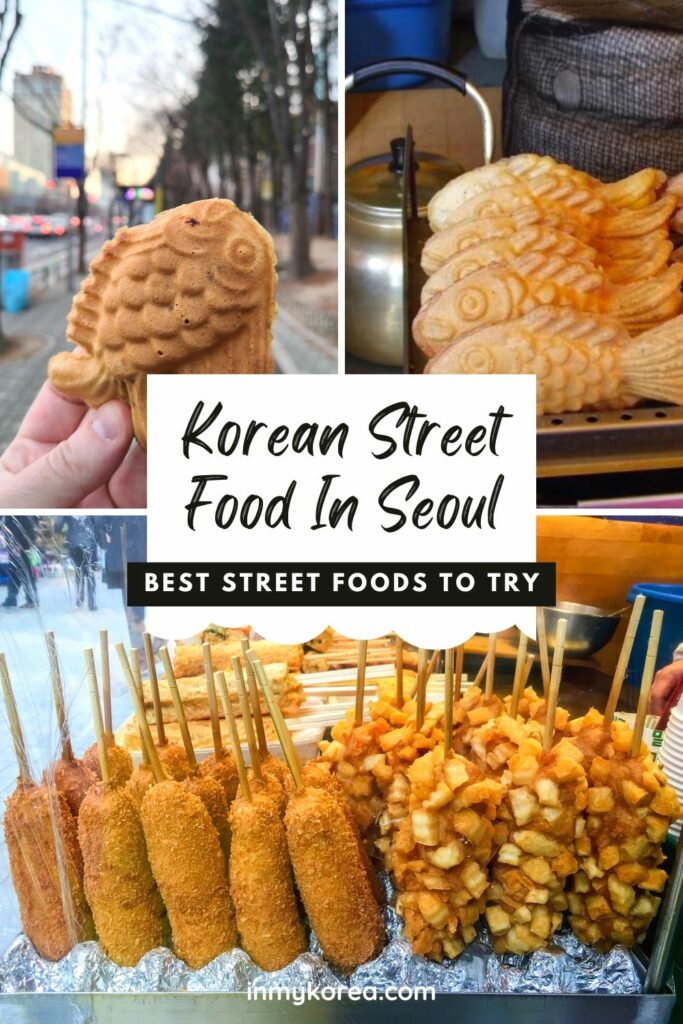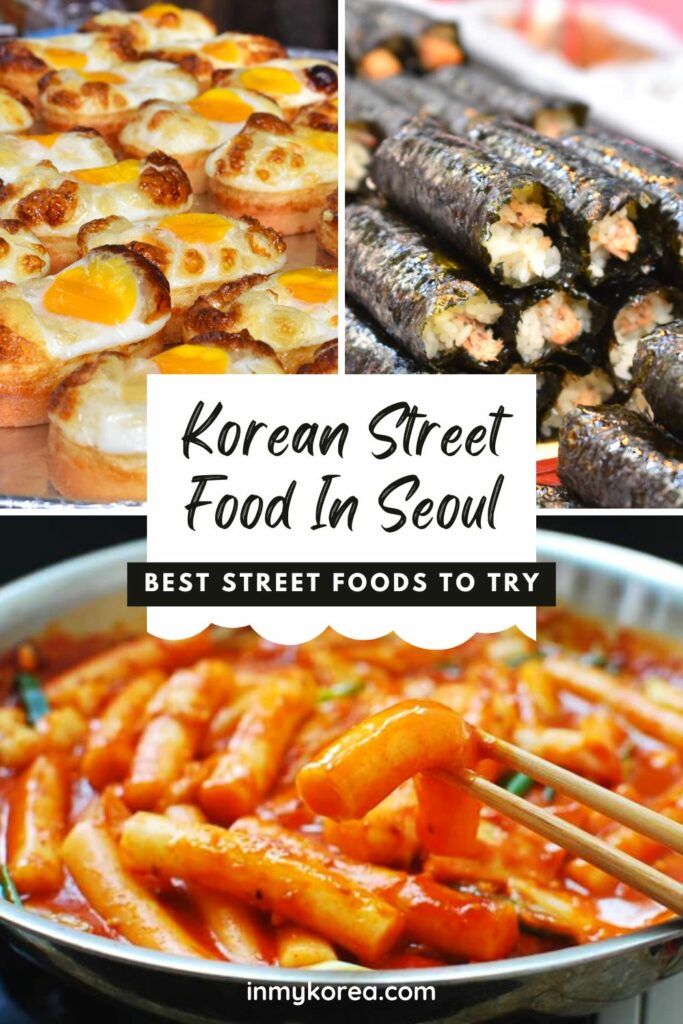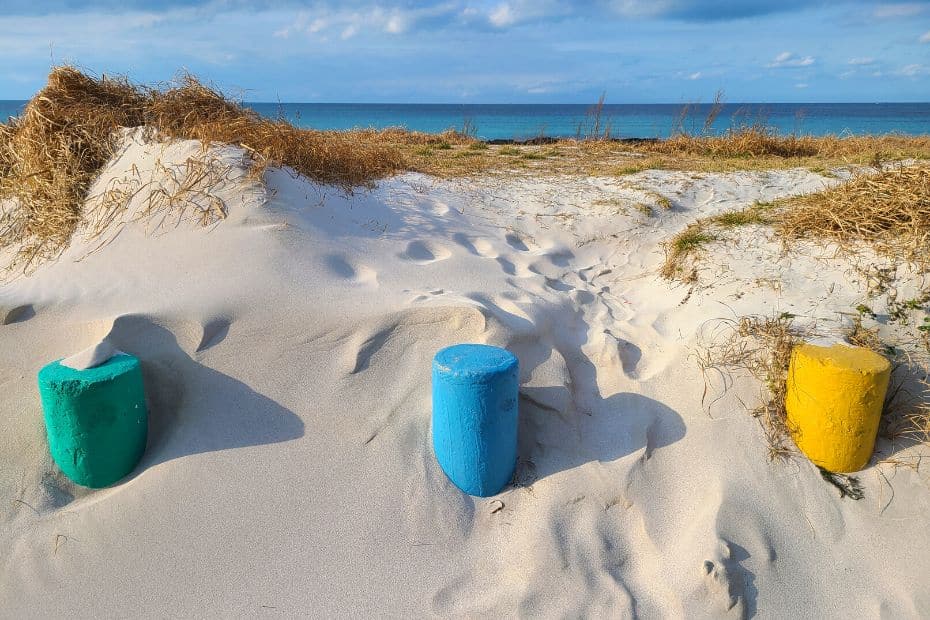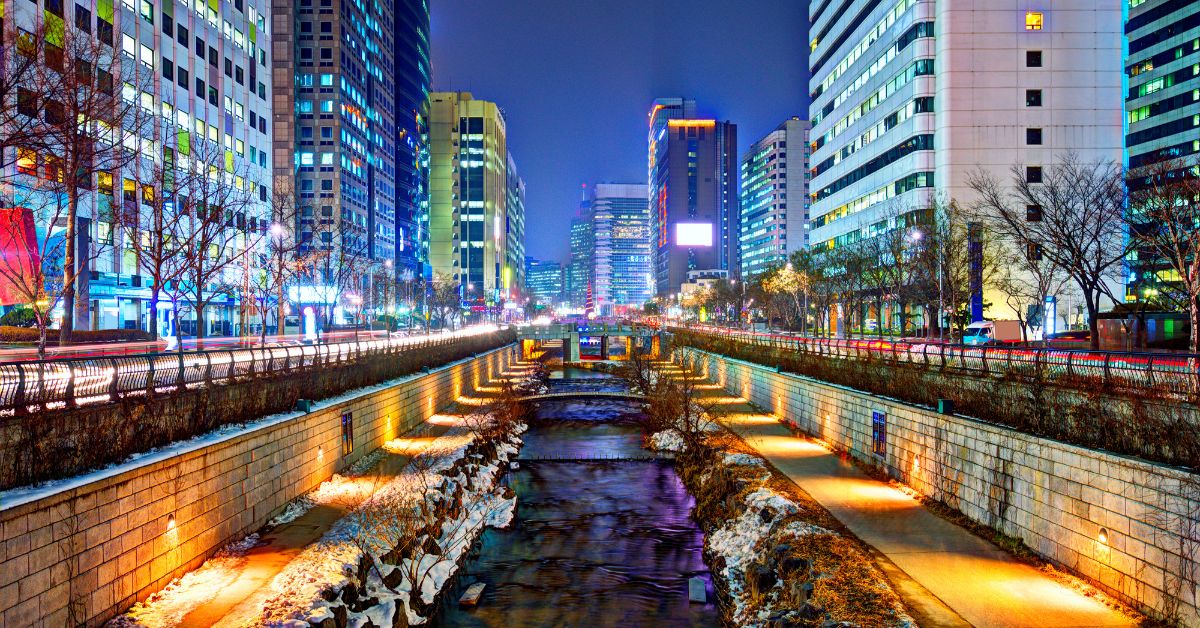If you’re visiting Seoul, you have to try the incredible Korean street food that’s available in traditional markets, from street stalls, and in modern food trucks. There are so many mouthwatering dishes waiting to be devoured, including tteokbokki, hotteok, dakgangjeong, eomuk, and much more. Once you taste street food in Seoul, you’ll want to eat it every day.
This article introduces the best street food in Seoul and where to try it. Discover why travellers flock to Myeongdong Street Food Alley, Hongdae’s food scene, Gwangjang Market, and other hot spots for street food in Seoul. There are some useful Korean phrases to help you order street food, too.
Affiliate Disclaimer: This site contains affiliate links and I may earn commission for purchases made after clicking these links.
The 30 Best Korean Street Food In Seoul
Not sure what street food snack to try first when you arrive in Seoul? Well, take a look at this list of the 30 best Korean street foods you’ll find in Seoul and take a note. The best thing – most of these street foods are really cheap, easy to find, and you can try snack on them as you explore Seoul’s streets.
Here are the 30 best Korean street foods in Seoul:
Tteokbokki (떡볶이)
Spicy Stir Fried Rice Cakes
The most famous of all Korean street food, tteokbokki is a must-try when you visit Seoul. Tteokbokki is a simple dish, but full of flavour and textures that are so rewarding together, especially on a cold day. It’s basically a big pot of sweet and spicy sauce with chewy rice cakes and a few slices of fish cake. Each tteokbokki stall has their own recipe, making their dish spicier or sweeter as their customers like it. Definitely grab a bowlful of tteokbokki and sample this classic Korean street food.
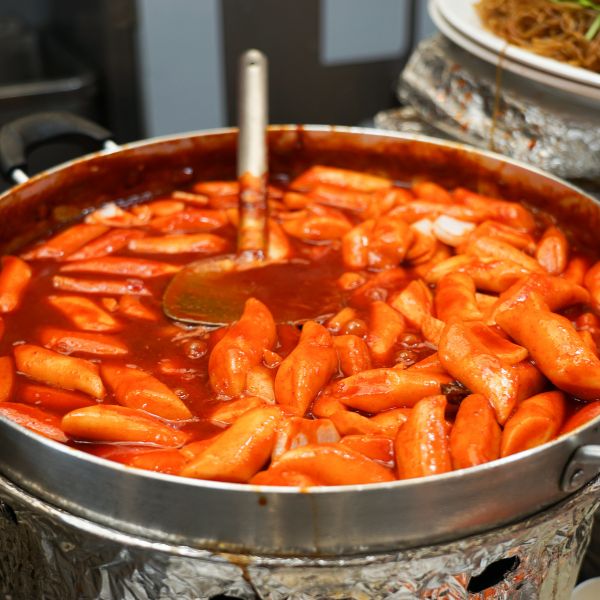
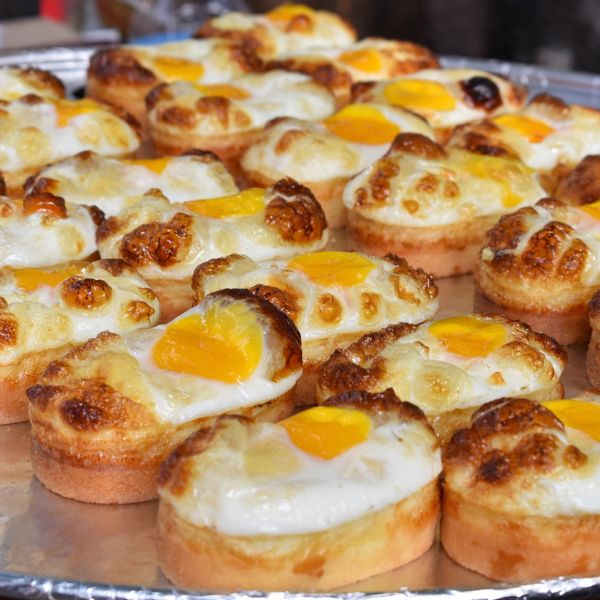
Gyeran-Ppang (계란빵)
Egg Bread
Gyeran-ppang is an iconic Korean street food that you’ll find in Myeongdong Street Food Alley and many other places. These eggy-delights are very straightforward – it’s an oval-shaped piece of bread with an egg dropped on top that’s baked on a hot plate. Gyeran-ppang are cheap and make a good breakfast or late-night snack when you’re out in Seoul. Just be careful when you eat them as the yellowy egg yolk is often runny.
Bungeo-Ppang (붕어빵)
Red Bean Goldfish Pastry
Bungeo-ppang are red bean filled pastries cooked in a special fish-shaped pan to give them an adorable look. This cute street food can be found all over Seoul’s street corners during the winter months when people need a sweet treat to heat them up. These are literally called ‘carp bread’ in Korean as it’s shaped like a carp. These street food snacks are cheap and can be snapped up for 2,000 won or less.
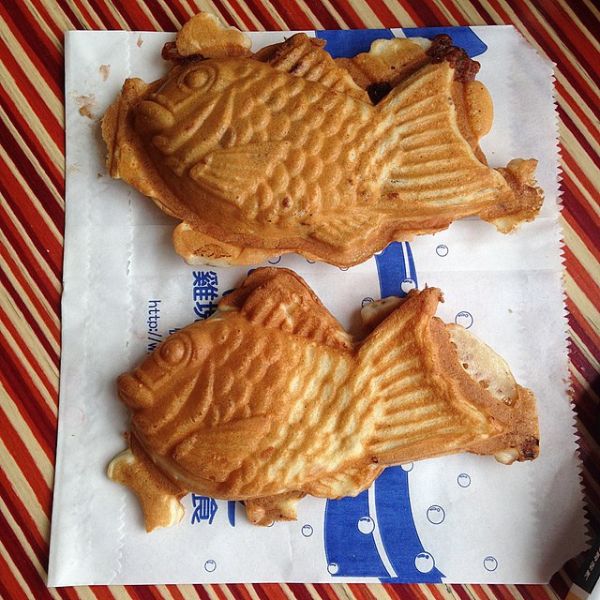
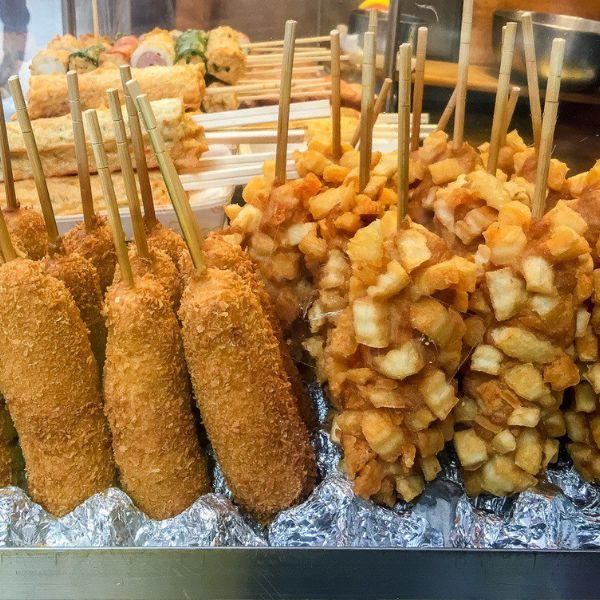
Gamja Hot Dogs (감자핫도그)
Korean-style Hot Dogs
A Korean street food classic that’s made waves around the world, gamja hot dogs (potato hot dogs) are a guilty pleasure for many in Seoul. Gamja hot dogs are based on corn dogs, but have taken them to a new level. Korean hot dogs have sausage and cheese inside and are coated in crispy breadcrumbs (panko). The hot dogs are deep fried until they’re crispy, then coated in sugar and tomato ketchup to give a sweet and savoury taste that’s irresistible.
Bindaetteok (빈대떡)
Mung Bean Pancakes
Bindaetteok are a Korean street food that are usually found in Seoul’s traditional markets, especially Gwangjang Market. These deceptively delicious pancakes are made with crushed mung beans that have added vegetables and sometimes meat. Bindaetteok are best when eaten fresh from the hot plate, dipped in a bowl of soy sauce, and accompanied with a bowl of plain makgeolli rice wine. It’s a real Korean experience you have to try.
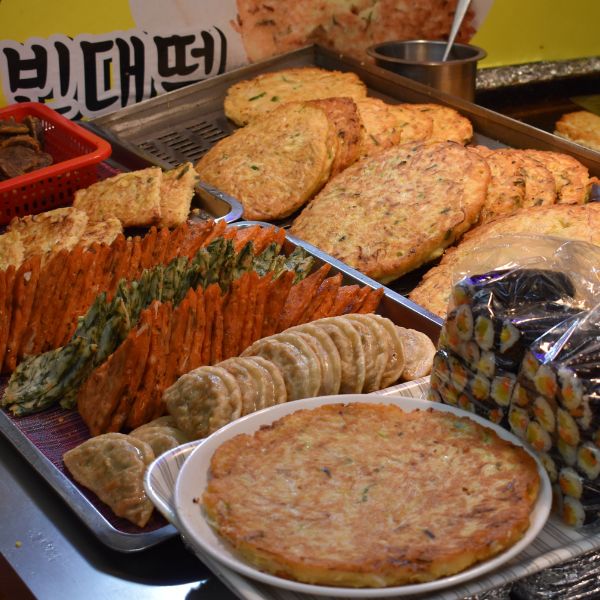
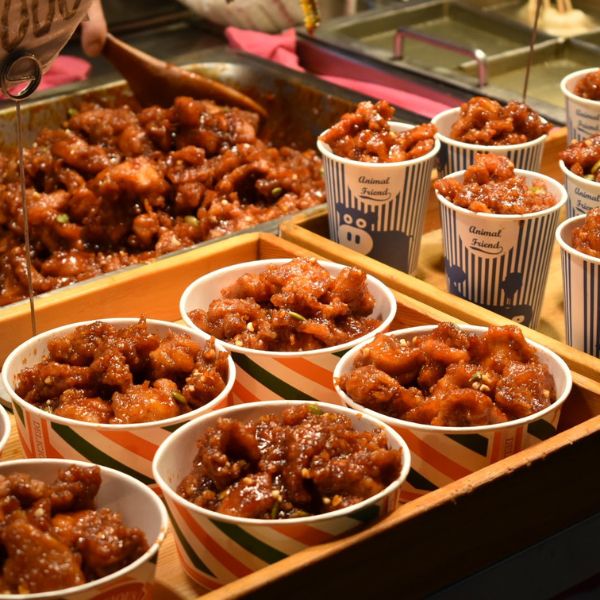
Dakgangjeong (닭강정)
Sweet-Crispy Fried Chicken
Korean fried chicken (the other KFC), is a popular indulgence on the weekend with a few cold beers and you’ll see many places serving chi-maek (chicken with beer) in Seoul. If you want to sample Korean fried chicken when you explore Myeongdong or Hongdae, try out a bowl (or bucket) of dakgangjeong. Discover amazing deep-fried chicken that’s covered in a uniquely Korean sweet-spicy-sticky sauce that’s finger-licking good!
Gilgeori Toast (길거리토스트)
Korean Street Toast
Gilgeori toast, which literally means ‘street vendor toast’ certainly doesn’t seem to be a traditional Korean snack, but it’s been around since the 1960s and remains incredibly popular as it’s cheap and filling. This street food snack is made with two slices of buttered bread that’s toasted until golden brown and then stuffed full with a variety of fillings, such as slices of ham, cheese, egg (scrambled), sliced veg, and even sweetcorn, all dressed in an unhealthy amount of sauce.
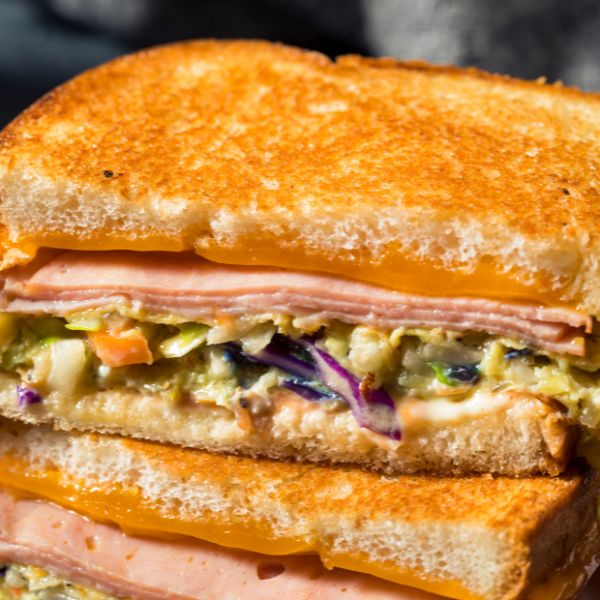
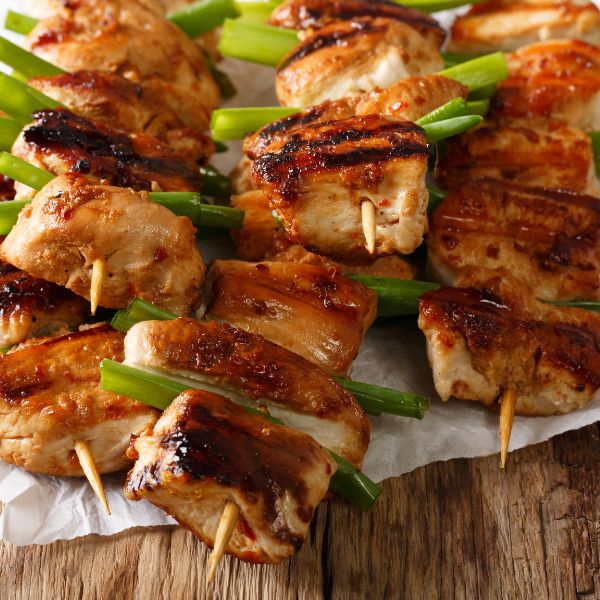
Dak-Kkochi (닭꼬치)
Skewered Chicken
There are several popular Korean street food snacks in Seoul that come on a skewer (kkochi), with the best of these being dak-kkochi. Dak-kkochi are typically made of alternating slices of chicken meat (dak) and spring onions (scallions). The dak-kkochi vendors put on the best performances among Seoul’s street food sellers, dancing with their handheld flame throwers while torching the chicken meat in front of you so it’s crispy and smoky.
So-Tteok So-Tteok (소떡소떡)
Sausage & Rice Cake Skewers
A plain yet delicious street food that’s popular with all ages in Korea is so-tteok so-tteok, which is a skewered snack made of chewy rice cakes (tteok) and mini Vienna sausages that are grilled and covered in various sauces. The rice cakes are the same as you get in tteokbokki, but they’re crispier as they’re grilled and not in a sauce, which is one of the best ways to eat them. So-tteok so-tteok make for a great snack in the morning or evening.
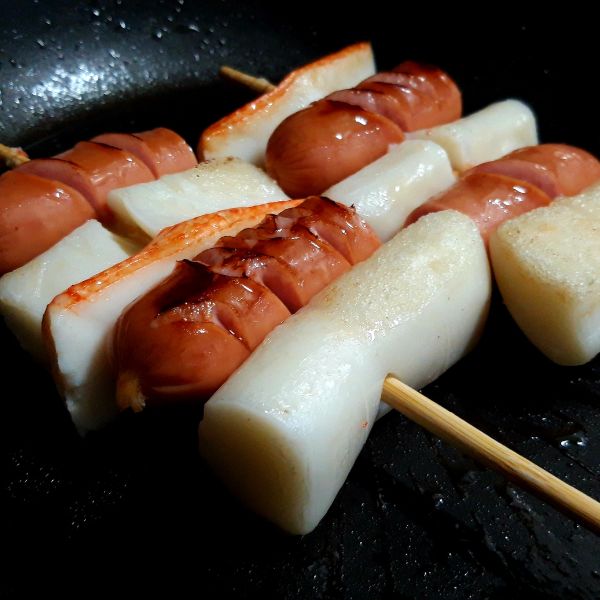
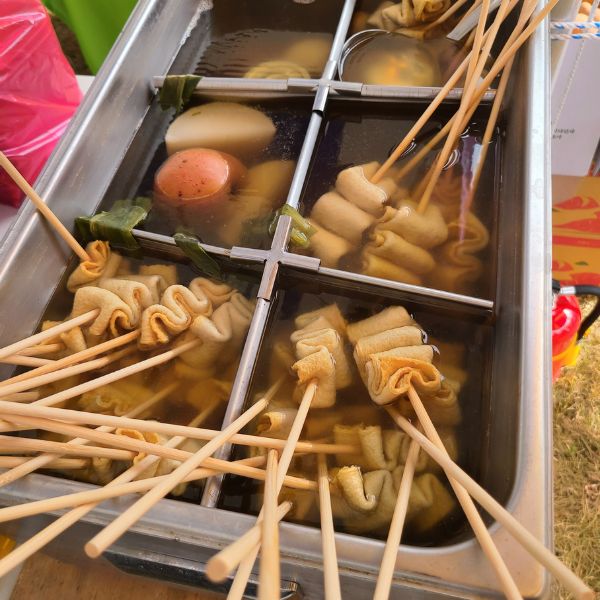
Eomuk / Odeng (어묵)
Fish Cakes Slices
An old-school Korean street food favourite that’s still popular all over Seoul with locals and tourists, eomuk is simply a thick-cut fish cake stuck on a long metal or wooden skewer. Eomuk are boiled in a salty broth that keeps them fresh and juicy and you usually get a cup of the broth to drink with the fish cake. These are also called ‘odeng’, based on the Japanese food ‘oden’, but Koreans are moving away from that name now.
Planning to visit Korea? These travel essentials will help you plan your trip, get the best deals, and save you time and money before and during your Korean adventure.
Visas & K-ETA: Some travellers to Korea need a Tourist Visa, but most can travel with a Korean Electronic Travel Authorisation (K-ETA). Currently 22 Countries don’t need either one.
How To Stay Connected: Pre-order a Korean Sim Card or a WiFi Router to collect on-arrival at Incheon Airport (desks open 24-hours). Alternatively, download a Korean eSIM for you travels.
Where To Stay: For Seoul, I recommend Myeongdong (convenient), Hongdae (cool culture) or Gangnam (shopping). For Busan, Haeundae (Beach) or Seomyeon (Downtown).
Incheon Airport To Seoul: Take the Airport Express (AREX) to Seoul Station or a Limo Bus across Seoul. Book an Incheon Airport Private Transfer and relax to or from the airport.
Korean Tour Operators: Tour companies that have a big presence in Korea include Klook, Trazy, Viator, and Get Your Guide. These sites offer discounted entry tickets for top attractions
Seoul City Passes: Visit Seoul’s top attractions for free with a Discover Seoul Pass or Go City Seoul Pass. These passes are great for families and couples visiting Seoul – you can save lots.
How To Get Around: For public transport, grab a T-Money Card. Save money on Korea’s high speed trains with a Korea Rail Pass. To see more of Korea, there are many Rental Car Options.
Travel Money: Use money exchanges near Myeongdong and Hongdae subway stations for the best exchange rates. Order a Wise Card or WOWPASS to pay by card across Korea.
Flights To Korea: I use flight comparison sites such as Expedia and Skyscanner to find the best flights to Korea from any country. Air Asia is a good option for budget flights from Asia.
How To Learn Korean: The language course from 90 Day Korean or Korean Class 101 both have well-structured lessons and lots of useful resources to help you learn Korean.
Ramyeon (라면)
Instant Noodles
Ramyeon noodles are the go-to meal for students and budget travellers who want to try Korean street food in Seoul without breaking the bank. Street food vendors in Seoul often serve ramyeon in golden metal bowls and give you a portion of kimchi or cheese to add to it. You’ll find these places in traditional markets. A bowl of instant ramyeon can be added to many different traditional Korean meals, including tteokbokki, but is just as good by itself.
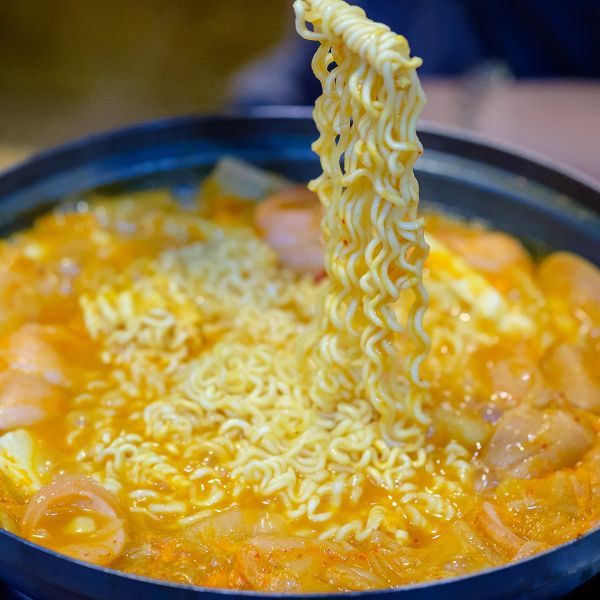
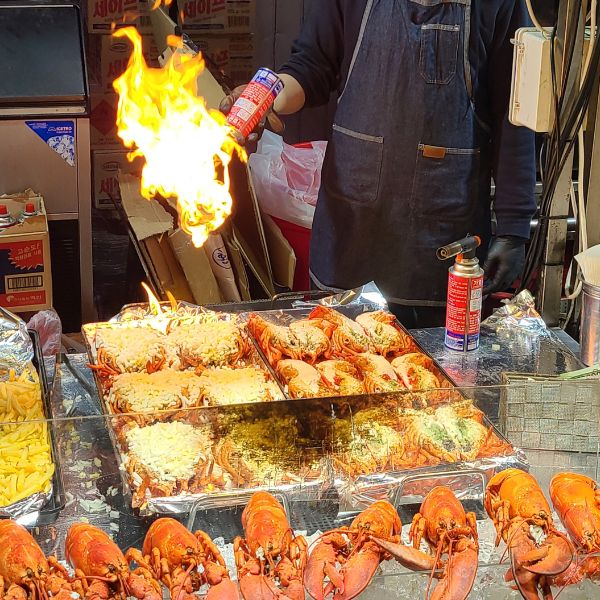
Grilled Cheese Lobster Tails
(치즈폭탄 랍스터 구이)
This is the most expensive street food in Seoul, but one that’s certainly worth trying if you’re hungry and visiting Myeongdong Street Food Alley. The soft, buttery lobster meat is cooked in the red lobster tail and stuffed with cheese. It’s flame-grilled by the street food vendors with a fiery torch that leaves the cheese crispy and the insides gooey and ready to eat. Scoop out the insides after posing for a photo with the most insta-worth street food in Seoul.
Sundae (순대)
Korean Sausage
Not to be confused with an ice cream sundae, Korean sundae (pronounced soon-dae) is a blood sausage that’s usually served in slices with a dipping salt. Sundae is a filling, meaty street food that’s perfect as a late night snack with a beer or a budget lunch. The main ingredients usually include pork, cellophane noodles, and rice, but regional variations might also include barley, kimchi, bean sprouts and perilla leaves. This is a salty dish, so make sure you have something to drink with it.
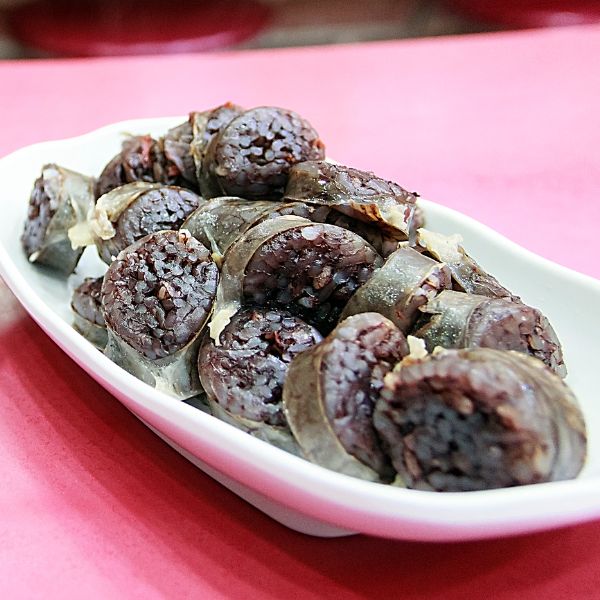
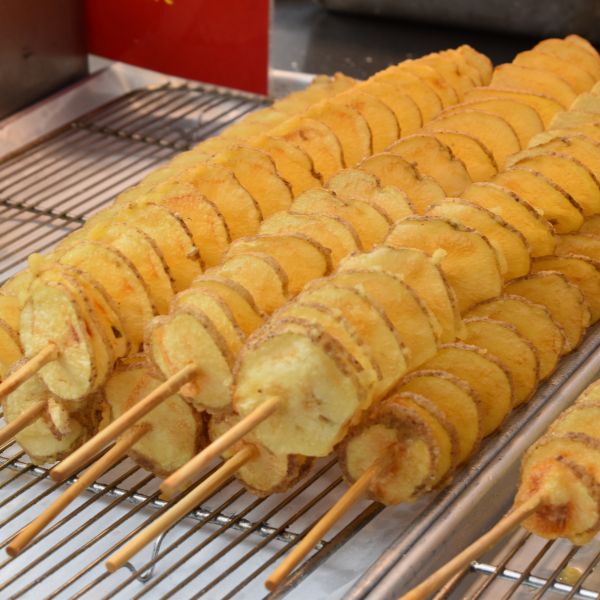
Hweori Gamja (회오리 감자)
Tornado Fries
Hweori Gamja, also called twisted potatoes or tornado fries, are a popular Korean street food that you’ll find in areas where young Koreans hang out like Myeongdong and Hongdae. Tornado fries were invented in Korea by Jeong Eun Suk and include a whole potato cut in a spiral and cooked on a skewer. You can add seasonings to the tornado fries, such as cheese, onion, or honey. They’re fun to eat as you walk around Seoul.
Twigim (튀김)
Korean Deep Fried Snacks
Twigim is the Korean word for ‘deep frying’ and this term relates to a collection of deep-fried foods coated in batter that are similar to Japanese tempura. In Korea, twigim street foods can include deep fried shrimp, pumpkin slices, peppers, perilla leaves, sweet potatoes, rice, and variety of other vegetables, fish and meat. When you get twigim as street food, you can pick your favourite deep-fried foods or order a mixed set called ‘modeum twigim’.
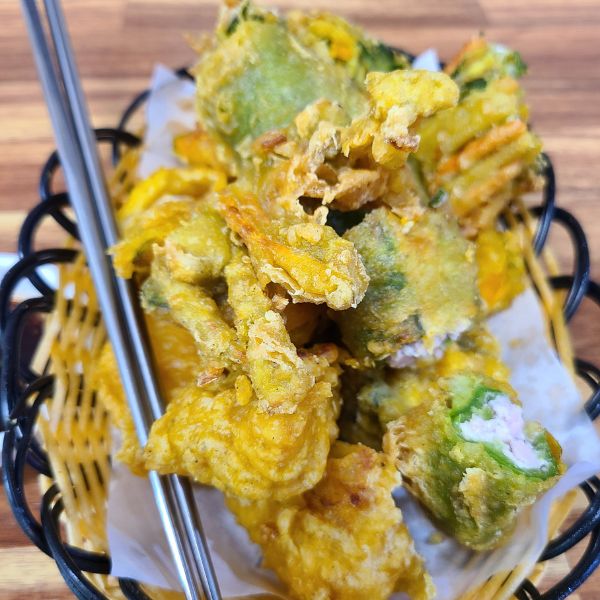
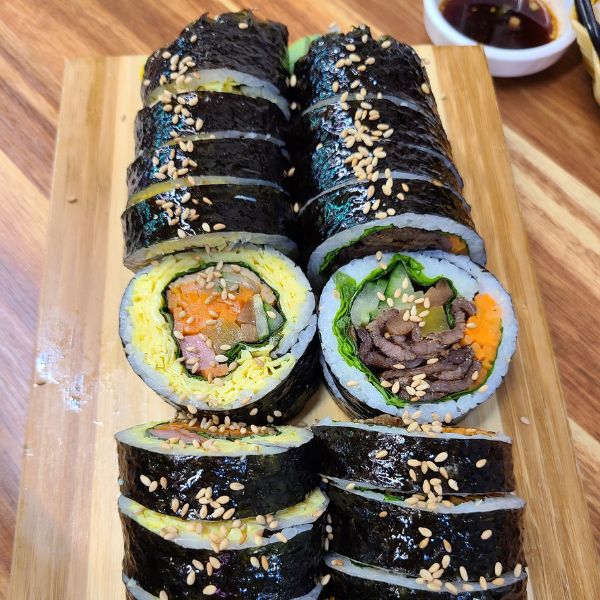
Gimbap (김밥)
Seaweed-wrapped Rice Roll
A classic Korean street food that provides millions of people in Korea with a cheap and filling street food snack or meal, gimbap is a dish made of filled rice wrapped in seaweed. There are dozens of varieties of gimbap, including tuna-mayo, battered shrimp, pork cutlet, beef, vegetables, scrambled eggs, fish cakes, and lots more. Gimbap, also called kimbap, are served in long rolls cut into slices or as small rolls that you eat individually (these are ggoma gimbap – little gimbap).
Guwun Garaetteok (구운 가래떡)
Korean Baked Rice Cake Bar
Rice cakes are found in many Korean street foods in Seoul, including tteokbokki and so-tteok so-tteok, but they are just as delicious when eaten by themselves, which is what you can do when you try guwun garaetteok. Garaetteok are long, cylindrical rice cakes that are soft and squidgy until they’re baked (guwun). Once baked, the garaetteok become crispy on the outside and chewy inside, making them a tasty treat that’s also healthy.


Mandu (만두)
Korean Dumplings
Mandu are Korean-style dumplings that are served steamed or fried and come with a range of fillings, including meat, kimchi, and shrimp. You can find mandu in Korean street food stalls in Myeongdong and Hongdae, as well as in traditional markets and you get around 5 mandu per portion. Steamed mandu shops are easily spotted due to the large clouds of steam billowing out from the front of the shop as mandu are being steamed and served.
Tanghuru (탕후루)
Sugar-Coated Fruits
A favourite of children in Seoul, tanghuru is a sweet Korean street food of fruits coated in rock sugar that give a crunchy bite of goodness. Various fruits can be used for tanghuru, but you’ll usually find bright red strawberries as they are the perfect size for skewering and snacking. The sugary coating is crunchy, not soft and sticky, which can be surprising when you first bite it. You’ll often find tanghuru stalls near the entrance to popular family-friendly attractions in Seoul.
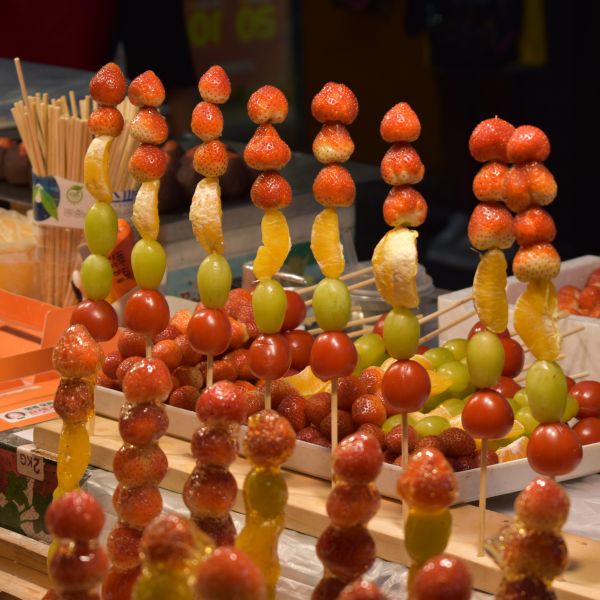
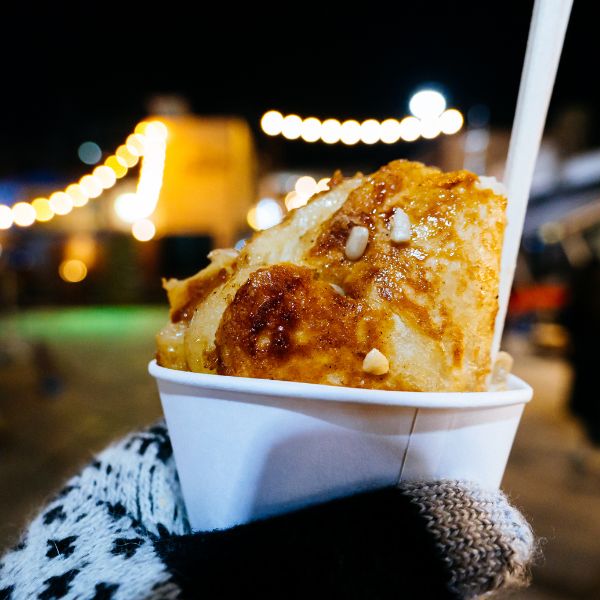
Hotteok (호떡)
Korean Sweet Pancakes
Hotteok are crispy pancakes that are packed with ingredients that can include honey, seeds, nuts, and cinnamon. They’re the perfect winter Korean street food snack as the warm, gooey honey and other fillings heat you up instantly. The hotteok vendors stuff a ball of dough with the sweet filling, then fry it an on oily hot plate until it’s flat and crispy before folding it up and squeezing it into a paper cup to serve. Make sure to ask for a fresh hotteok so the insides are runny and hot.
Gun-Bam (군밤)
Roasted Chestnuts
Roasted chestnuts, a popular street food snack in autumn and winter, are cooked in a large metal pan or spun in a metal oven until their shells crack, allowing you to eat the soft, smoky chestnuts inside. Roasted foods like this are common in Korea when it’s cold and provide a cheap snack for people who want a nutritious bite to eat, which you might need if you’ve only been eating tteokbokki for the rest of the time.
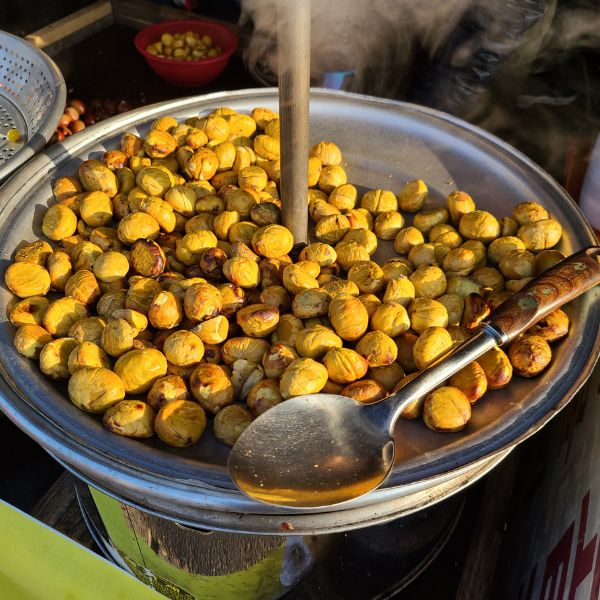
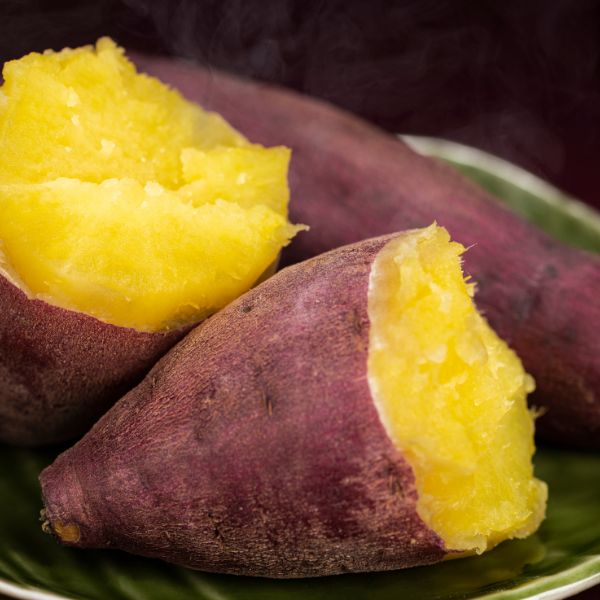
Gun-Goguma (군고구마)
Roasted Sweet Potatoes
Another roasted Korean street food that’s healthy, cheap, and filling is gun-goguma, or roasted sweet potatoes. Sweet potatoes are more common in Korea than regular potatoes and you’ll find vendors and convenience stores roasting these fresh. You can find them by following your nose to the smoky rocks that these sweet potatoes are roasted on. Peel away the skin and enjoy the soft insides.
Hodu-Gwaja (호두과자)
Walnut Cakes
Hodu-gwaja are bite-sized baked goodies that are made with crushed walnuts in the flour to give them a lovely, nutty texture. These walnut cakes are filled with the ever-popular red bean paste that’s at the centre of so many delicious Korean sweet treats. You’ll find these in Seoul in street corner carts where you can buy a bag with a dozen or more hodu-gwaja inside. Hodu-gwaja are perfect for snacking at any time.
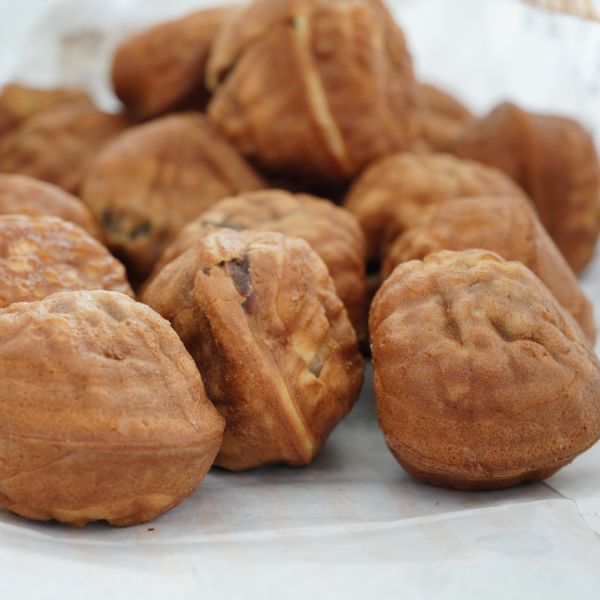
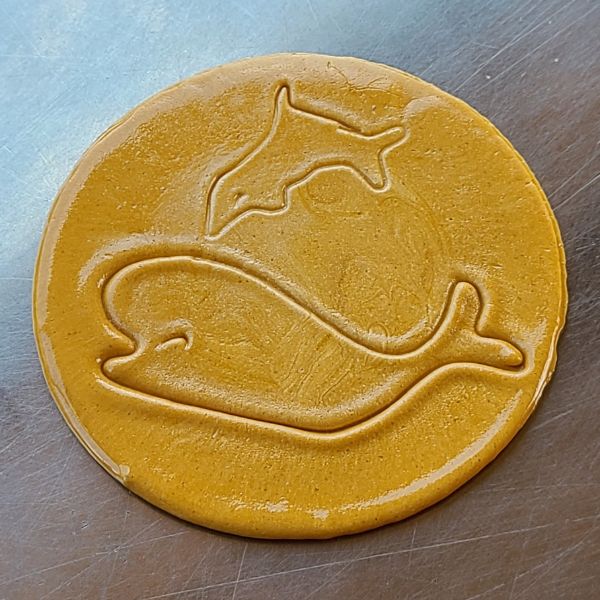
Dalgona (달고나)
Korean Sugar Candy
Dalgona is a Korean sugar candy that was made famous internationally by the first season of Squid Game, but has been beloved in Korea for generations. You can buy this sugary snack from street food vendors who make it fresh and then print cute designs as it’s cooling. Dalgona used to be very cheap (1,000 KRW), but after the success of Squid Game, prices jumped and can be quite expensive (3,000 KRW+), especially in touristy areas.
Jjinppang (찐빵)
Korean Steamed Buns
Jjinppang, also known as hoppang, is a steamed bun that’s filled with sweet red bean paste and bits of broken up beans and best eaten fresh from the steamer where they’re kept warm. These white buns can also be filled with chocolate, cheese, meats, and more, but are most commonly filled with red beans. Jjinppang is a traditional Korean street food that’s similar to Chinese bao buns and these days are most commonly found inside convenience stores than on the street.

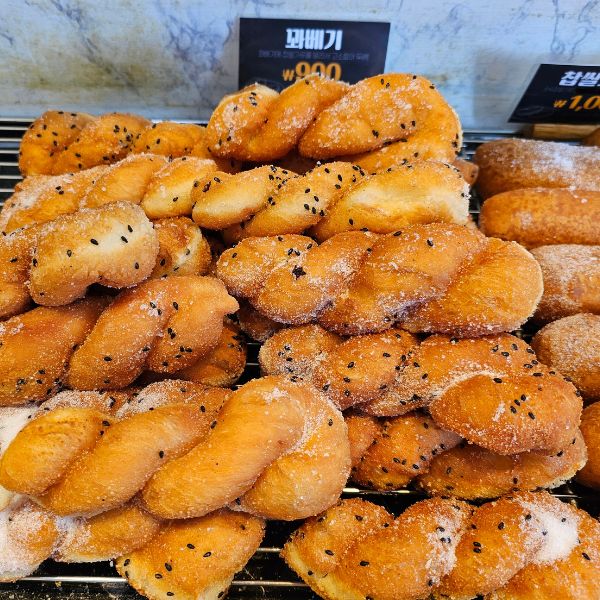
Kkwabaegi (꽈배기)
Twisted Korean Doughnuts
An old-school Korean street food that has long provided Korean children with a sweet, filling snack during their tough days of studying, kkwabaegi are similar to fried doughnuts but are long and twisted instead of round. Kkwabaegi are made from wheat or rice flour dough with melted butter, deep-fried in oil, and then dipped into trays of powdered sugar and cinnamon to give them a sweet coating. They’re one of the cheapest street foods in Seoul and go really well with a cup of coffee for breakfast.
Gukhwa-Ppang (국화빵)
Chrysanthemum Bread
Sweet red bean paste is found in many traditional Korean street food snacks, especially in baked goods. Gukhwa-ppang, or chrysanthemum bread due to their flowery design, is a flower-shaped bread that’s bursting with red bean paste and is a great winter warmer. Like a waffle, this snack is baked in a flower-shaped mould, trapping in and heating the red bean paste in the centre, waiting for you to discover it when you bite into it.
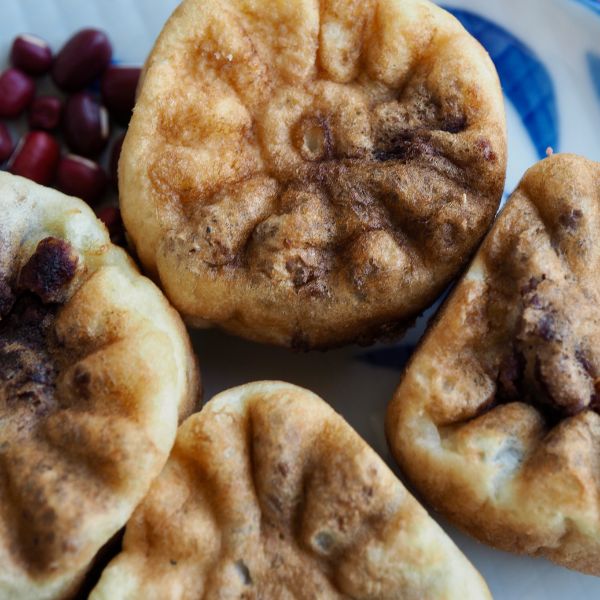
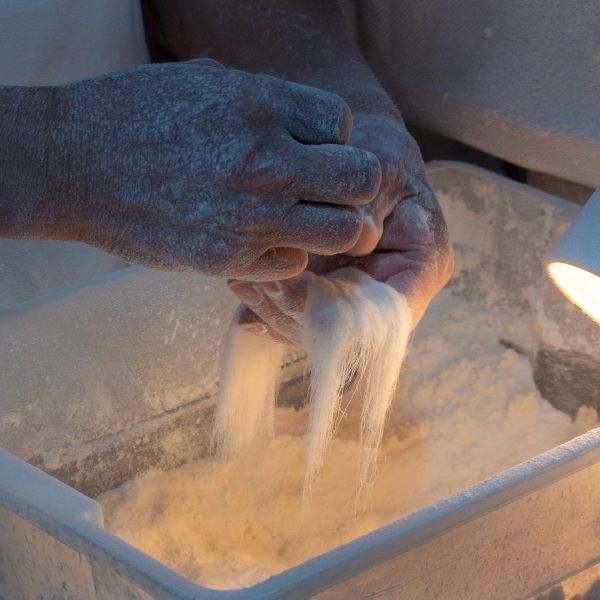
Kkul-Tarae (꿀타래)
Dragon’s Beard Candy
Dragon’s beard candy, known as kkul-tarae in Korea (honey-stein) or Korean court cake, is one of the most unique looking street foods in Seoul. The silky, hair-thin strands of honey-based candy that wrap the chewy insides are said to resemble a dragon’s beard when they get caught on your chin while eating these sweet snacks. These desserts aren’t that common in Seoul, but you can still find some vendors in the artistic Insadong area.
Ppeongtwigi (뻥튀기)
Korean Puffed Rice
Ppeongtwigi is a puffed grain snack that’s usually made from rice and corn and formed into round disks for snacking. Originally from the USA, the method of making puffed grains eventually ended up in Korea and became very popular in the early 20th Century. Puffed rice cakes are healthy snacks and you can buy big packets of them for a low price and in some places you can see them being shot out of the machine into a basket, ready to eat.
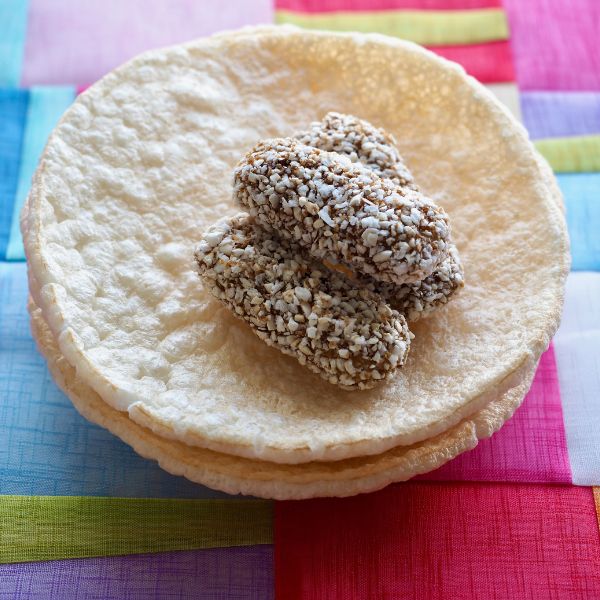
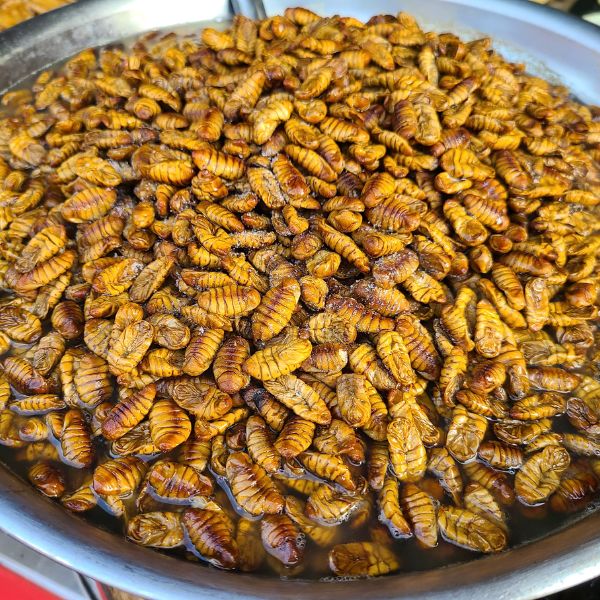
Beondegi (번데기)
Silkworm Pupae
Beondegi is a weird Korean food that will probably make tourists in Seoul curious or even squeamish. This smelly street food is simply boiled or steamed silkworm pupae scooped up into a paper cup and eaten with a toothpick. Koreans don’t eat many insects, but thanks to the health benefits from the high-quality, low-fat protein found in beondegi, these have remained popular. Be warned, the smell of these boiling bugs is quite strong and not that easy to digest.
Best Places To Try Korean Street Food In Seoul
There are many places to try Korean street food in Seoul, such as at traditional markets, food stalls, food markets, riverside parks, and outside popular attractions. You can find street food in every corner of Seoul, but the most convenient places are usually in touristy areas or in older parts of Seoul.
Street food vendors in Seoul work almost every day in traditional markets and street food stalls, but there are also weekend-only spots where food trucks descend in busy areas to feed hungry Seoulites. During festivals, such as spring cherry blossom festivals, you’ll also find temporary street food stalls.
Here are some of the best places to find street food in Seoul:
Myeongdong Street Food Alley & Night Markets
The most popular place to try Korean street food in Seoul has to be Myeongdong Street Food Alley. This wide street in central Seoul is lined with food stalls selling all kinds of traditional and modern street foods, including cheesy lobster tails, tornado fries, gyeran-ppang, and tteokbokki. The entrance to Myeongdong Street Food Alley is opposite the Lotte Department Store. Myeongdong’s markets spread across many streets and include street foods, souvenirs, cosmetics, and more.
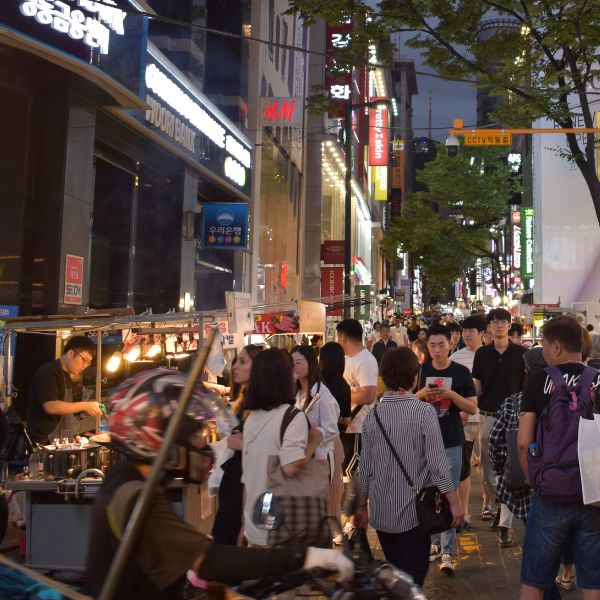
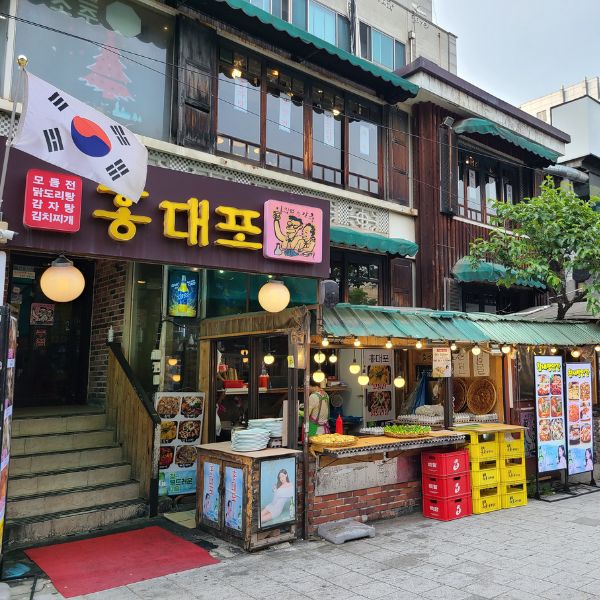
Hongdae Shopping Street
Hongdae Shopping Street, which runs from Hongik University through the heart of Hongdae, is a great place to try modern Korean street food and enjoy the cool culture that this area is famous for. Munch on some fried chicken or hotteok while watching street performances in the evening, or get some tanghuru to go with your morning coffee. There are plenty of sweet treats to try in this area and it’s a great area to stay in Seoul.
Gwangjang Traditional Market
Gwangjang Traditional Market is Seoul’s most famous market for street food and was the star of the Netflix show Street Food. In the Seoul episode it showed bindaetteok from Gwangjang Market, which is definitely the best place in Seoul to try this satisfying street food. There’s a load of other delectable traditional street foods in Gwangjang Market, including sundae, mandu, ramyeon, and more. Don’t miss it.
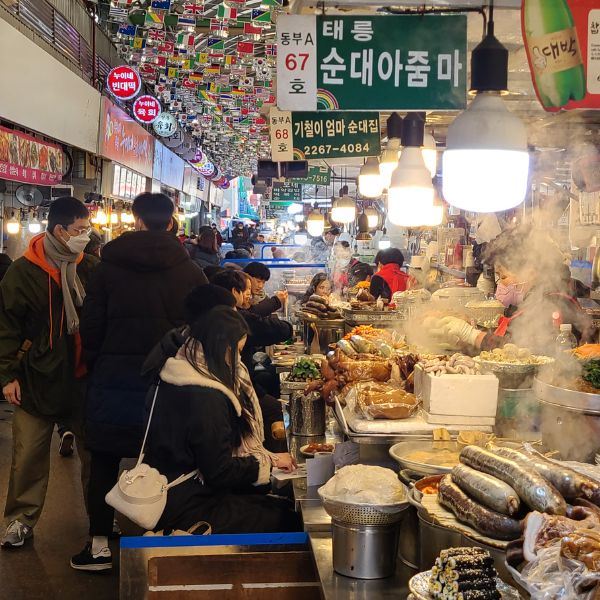
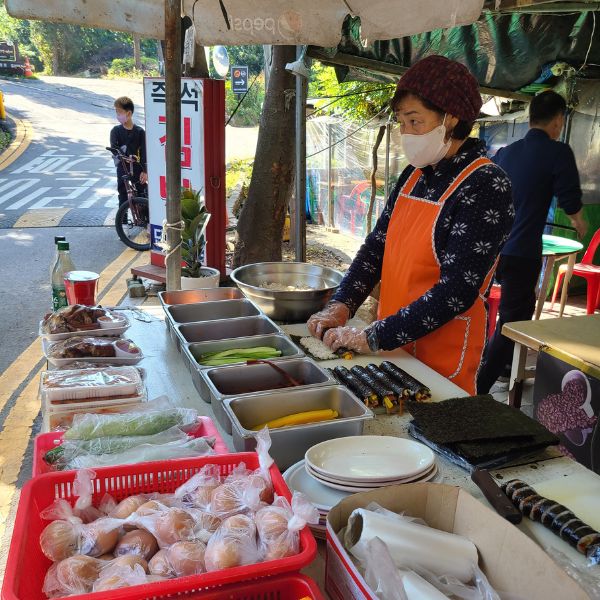
Bukhansan National Park
If you plan to hike Seoul’s Bukhansan National Park, make sure you top up on some delicious street food snacks before you go to give you energy, including hotteok and garaetteok. You’ll find vendors selling freshly made gimbap at the park’s entrance, too, which is perfect to put in your backpack and bring with you and eat as you reach Baegundae Peak. There’s also tteokbokki and other traditional Korean street foods to try at the main park entrance.
Namdaemun Market
Another traditional market in Seoul with street food is Namdaemun Market, which opens from late morning until late at night. Namdaemun Market is often mistaken as Myeongdong Market as it’s very close and can be accessed from Hoehyeon Station, which is one stop before Myeongdong Station. This market is a bit more traditional than Myeongdong, so expect to find classic street foods such as hotteok, beondegi, kkwabaegi, and tteokbokki.
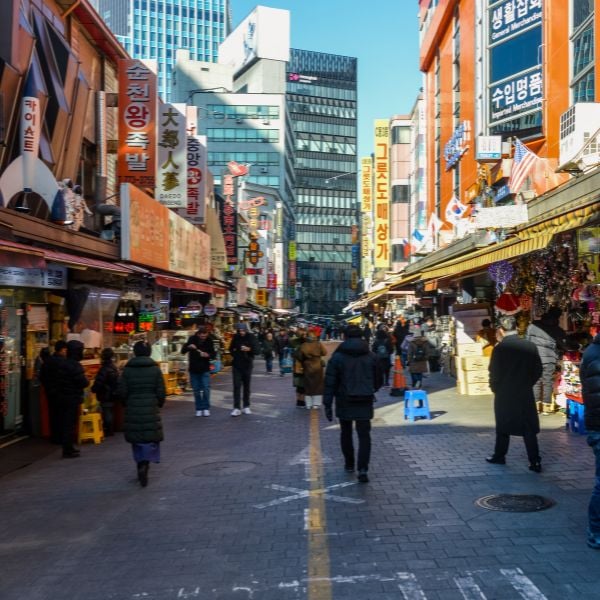
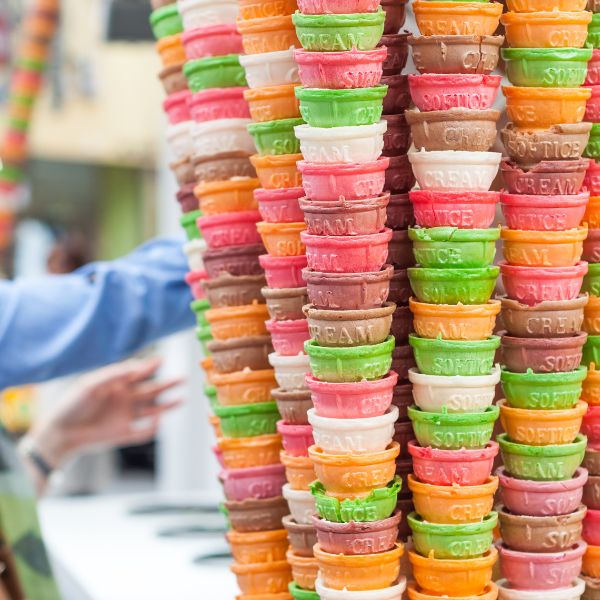
Insadong Art Street
Insadong Art Street is a fun area in central Seoul that’s close to several royal palaces, Jogyesa Temple, and other historic sights. The side streets in this area are full of traditional Korean restaurants and old wooden tea houses. However, the main street is a unique blend of Korean and international, with street food vendors selling dragon’s beard candy, Turkish ice creams, tteokbokki, and rice cakes.
Euljiro Neighbourhood
Euljiro, an area north of Myeongdong and around Cheonggyecheon Stream in central Seoul, is packed with street food stalls, bars, and restaurants that are popular with locals and tourists alike. Head to Jonggak Avenue of Youth near Jonggak Station for a lively bar scene with street food vendors in the main street, or wander outside Euljiro 3-ga Station to see Euljiro Pojangmacha Street, full of street food stalls where you can sit and eat under covers.
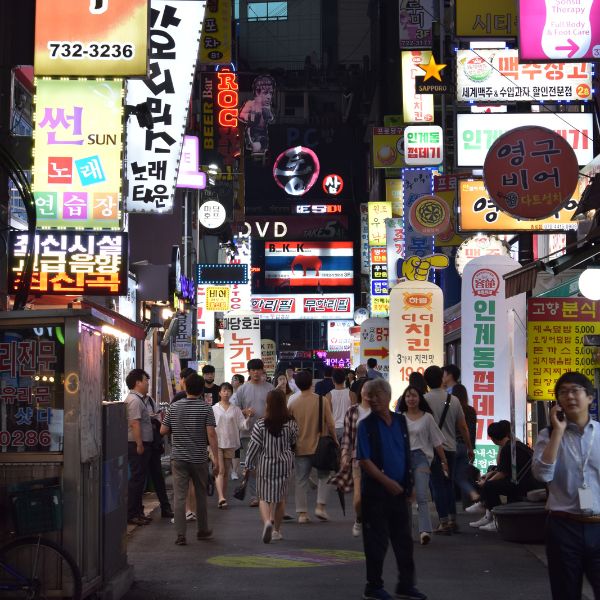
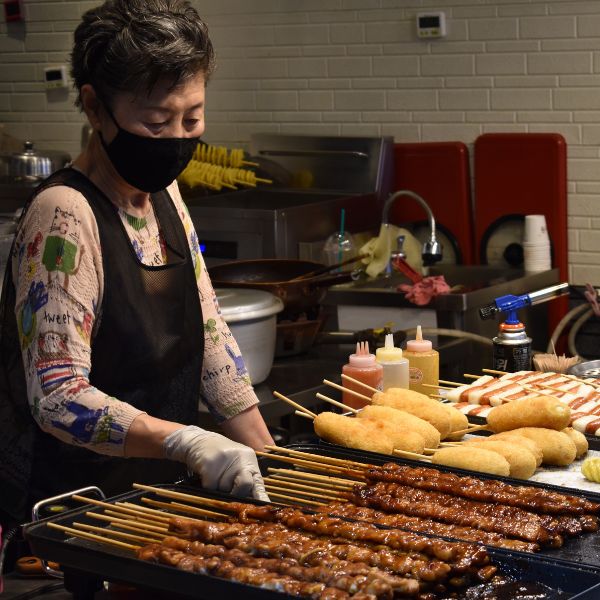
Mangwon Market
Mangwon Market, close to Mangwon Station, is less touristy than Hongdae, Namdemun, and Myeongdong markets and you will find more traditional Korean street foods and restaurants here. This market near Hongdae is perfect for stocking up before visiting the nearby Han River parks or snacking as you explore the side streets and back alleys of Mangwon. There are lots of nice cafes and bakeries in this area for lunch, as well as famous Korean fried chicken restaurants where you can experience a night-time food tour.
Seoul’s Night Markets
If you’re visiting Seoul from late spring to autumn, you’ll find lots of yummy Korean street food stalls at Seoul’s summer night markets, including the Goblin Night Markets that run at various times and in various locations in popular night-time spots, including Yeouido Hangang River Park, Cheonggyecheon Stream, and Dongdaemun Design Plaza. You’ll find the best street food trucks selling traditional, modern, and fusion food at these markets.

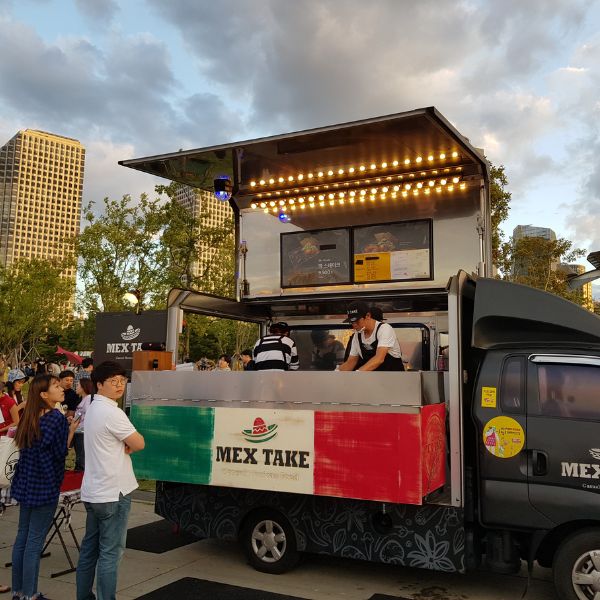
Street Food Trucks In Seoul
Seoul’s street food trucks offer an impressive array of dining options, from traditional tteokbokki to flame-grilled chop-steak, foreign foods with a Korean twist, and lots more. You can find street food trucks in many locations in Seoul, including the Han River Parks (especially Yeouido), near Seoul Forest, Olympic Park, night markets, Seokchon Lake, weekend markets, festivals, and parades. You can usually find them on weekends and holidays, as well as in spring and autumn.
Fun Korean Food Tours In Seoul
Want to try traditional Korean food in Seoul but not sure where to go and which one of the many options you should try? Why not book a street food tour or Seoul food tour and discover the best bites, make friends, and have fun exploring Seoul’s day or night dining scene.
Here are some of the best food tours available in Seoul:
Seoul Night Food Tour
Discover Seoul’s lively night scene in Euljiro in this evening tour of Seoul. Meet your local guide and walk, talk, and eat your way around the bustling streets and traditional markets while experiencing ‘hansik’ – Korean traditional meals and snacks. See where BTS visited and took a photoshoot, pass by Cheonggyecheon Stream, and even try some Korean cocktails.
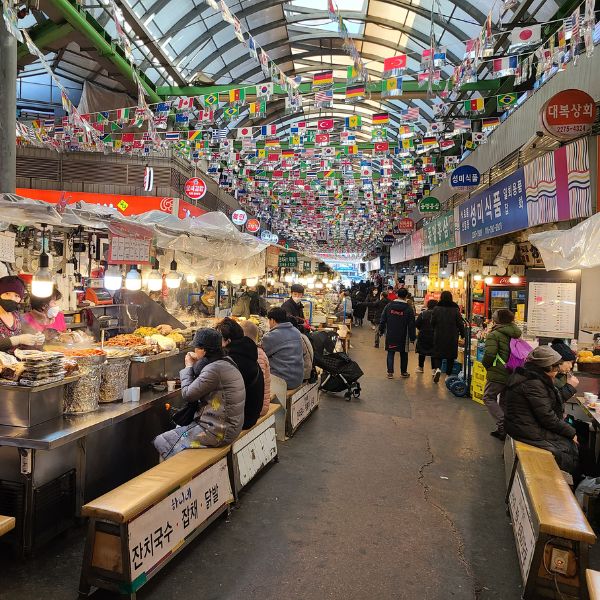
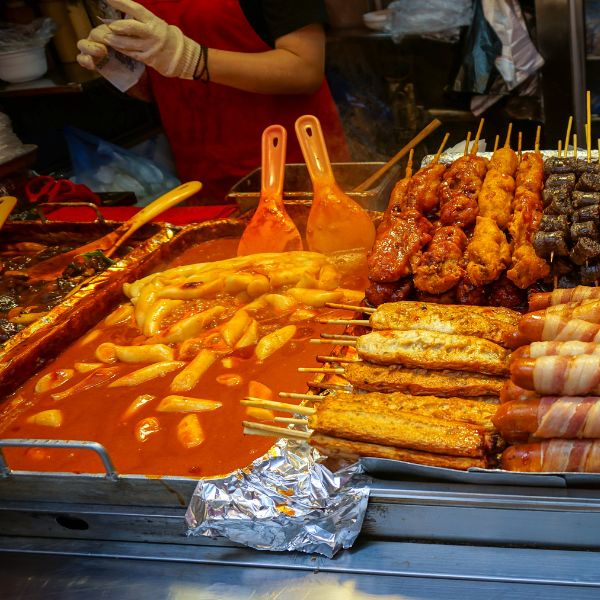
The 10 Tastings of Seoul
Eat your way through Seoul’s most popular traditional markets on this 3-hour private Korean food tour that’s perfect for travellers looking to skip the tourist trap restaurants and eat like a local. Experience 10 Korean street food dishes and local cuisine that’s been hand-picked by a local guide who’s passionate about Korean food. Eat and learn about local culture at the same time.
Chicken & Beer Experience
Explore the authentic chicken restaurants of downtown Mangwon, home to some of Seoul’s best establishments and loved by locals. This chicken and beer experience will take you to 3 different chicken restaurants, introducing you to 90s style Korean fried chicken, country-style barbecue chicken, and sizzling boneless fried chicken in a unique WWII setting. The tour includes all drinks and food and will show you areas of Seoul you might not normally visit as a tourist.
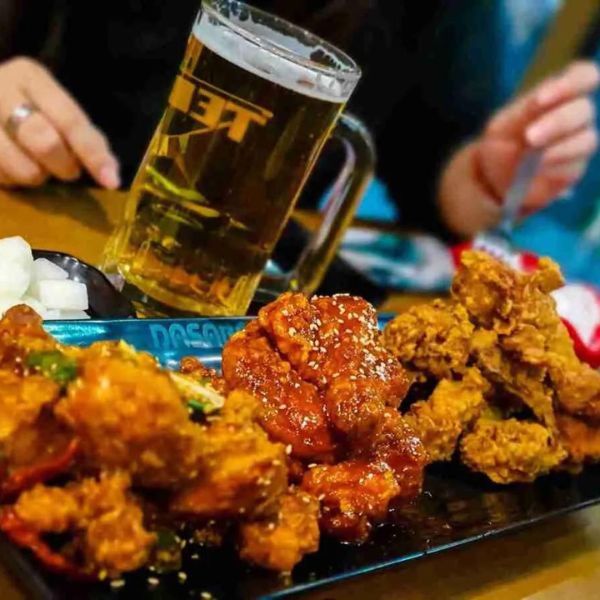
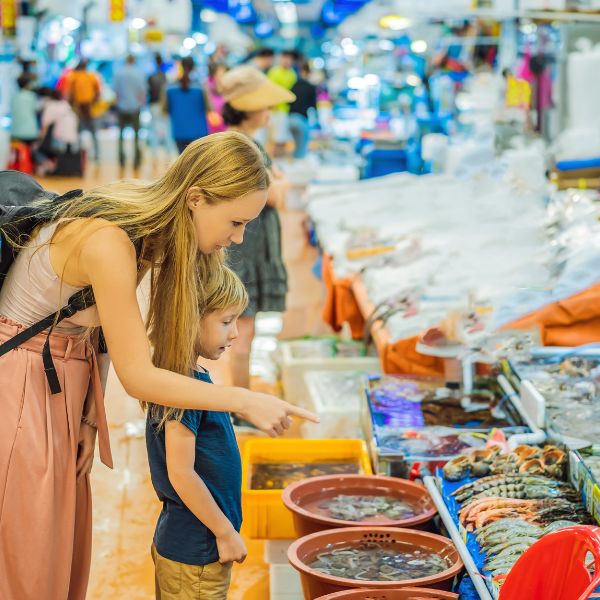
Noryangjin Fish Market Tour
If you want to try fresh fishy street food, then this tour of the Noryangjin Fish Market could be right up your alley. This is the best place to eat fresh seafood in Seoul and offers some of the best prices, too – better than you’ll find in restaurants. This tour of Noryangjin Fish Market will allow you to try various seasonal fish and seafood dishes while your guide tells you what each unusual sea creature is.
Korean Phrases To Buy Street Food In Seoul
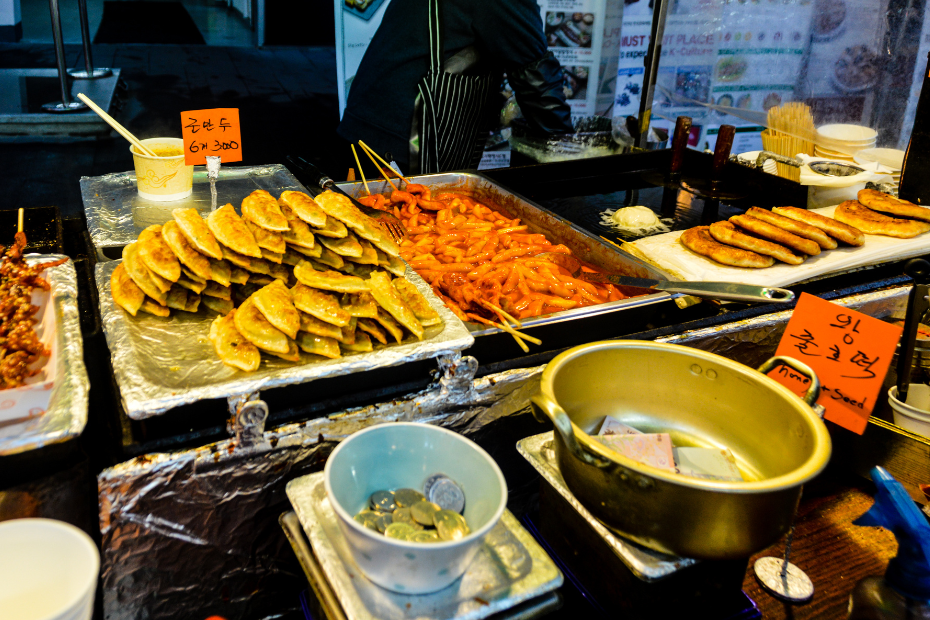
Korean is a unique language and hard to learn, especially for travellers from English-speaking countries. Fortunately, there are a few simple Korean phrases you can use to help you order food in Korea, ask for prices, and give compliments. Using these will impress Seoul’s street food vendors.
Besides speaking Korean, which will definitely impress the locals, there are a few Korean etiquette rules that you might want to be aware of. Did you know you shouldn’t tip when you buy food or drinks? Also, remember to take off your shoes inside traditional restaurants and don’t cross your legs.
Here are 12 useful phrases to use when ordering street food in Seoul. If you’d like to learn more phrases, check out my guide to phrases for eating out in Korea, which covers dietary requirements, ordering out, eating in a restaurant, and lots of useful Korean cultural and language insights.
| English | Korean (phonetic) | Korean (written) |
|---|---|---|
| How much is this? | Ol-ma-yeh-yo? | 얼마예요? |
| What is this? | Ee-goh mwo-yeh-yo? | 이거 뭐예요? |
| Is this spicy? | Ee-goh mae-wo-yo? | 이거 매워요? |
| Non-spicy, please. | Maeb-geh ha-ji mal-ah-ju-seh-yo. | 맵게 하지 말아주세요 |
| Is this suitable for vegetarians? | Chae-shig-ju-wee-ja-ga mog-eul su iss-oh-yo? | 채식주의자가 먹을 수 있어요? |
| I’ll have __, please. | __ ju-seh-yo. | __ 주세요. |
| One more, please. | Ha-na doh-yo ju-seh-yo. | 하나 더요 주세요. |
| That’s all. | Geu-geh da-yeh-yo. | 그게 다예요. |
| Can I pay by card? | Ka-deu-roh nael soo iss-oh-yo? | 카드로 낼 수 있어요? |
| Can I pay with cash? | Hyun-geum-eu-ro nael soo iss-oh-yo? | 현금으로 낼 수 있어요? |
| This is delicious. | Ma-sshi-soh-yo. | 맛있어요. |
| Enjoy your meal. | Ma-shi-geh deu-seh-yo. | 맛있게 드세요. |
If this article has whetted your appetite, be sure to check out my other Korean food-based articles, including the best Korean side dishes and the best traditional Korean dishes. There are lots of delightful and unique foods to try when you travel to Korea. Be brave, try them all.
Korean Street Food FAQs
Finally, here are a few FAQs about Korean street food in Seoul, in case the above information didn’t cover enough for you. If you have any other questions you’d like to ask, feel free to leave a comment.
Where can I try Korean street food in Seoul
There are many places to try Korean street food in Seoul, including Myeongdong Street Food Alley and Hongdae Shopping Street. Traditional markets such as Gwangjang Market, Namdaemun Market, and Mangwon Market also offer a wide range of traditional Korean street foods at low prices.
Is Korean street food in Seoul cheap?
Korean street food is a popular option for budget-conscious travellers as it is cheap and filling. There are many street foods that cost less than 5,000 Korean won or even 3,000 Korean won, including gimbap, tteokbokki, hotteok, bungeo-ppang, gamja hotdogs, and dak-kkochi. However, since 2023, street food prices in Seoul have risen considerably as vendors try to recover lost income and some places, such as Myeongdong, now charge significantly more for street food than in 2019.
Where’s the best place to eat street food in Seoul
The best place to eat street food in Seoul is Gwangjang Market in Seoul’s Dongdaemun area. This traditional market serves a wide range of popular Korean street food snacks and meals, including bindaetteok, sundae, gimbap, mandu, tteokbokki, and so-tteok so-tteok. The price of street food in Gwangjang Market is often lower than the price charged in Hongdae or Myeongdong, too.
Is Korean street food spicy
The most famous Korean street food is tteokbokki, which is a spicy dish with stir-fried rice cakes inside. The level of spice depends on the vendor and may be anything from mild to very spicy. However, there are many Korean street foods in Seoul that aren’t spicy at all, such as eomuk, gyeran-ppang, bungeo-ppang, hotteok, and gilgeori toast. Generally, Korean street food that’s red in colour is likely to be spicy as it may have a spicy coating made from chilli peppers.
What are popular Korean street foods?
Popular Korean street foods you can try in Seoul include tteokbokki, bindaetteok, dak-kkochi, dakgangjeong, hotteok, eomuk, gamja hotdogs, and tanghuru. There are many types of street food in Korea, including spicy dishes, sweet desserts, baked goods, and savoury snacks. Popular street foods involve tteok – round, long rice cakes that are the main ingredient for tteokbokki and so-tteok so-tteok.
Liked This? Pin It For Others
If you enjoyed reading this article, then please share this with your friends on Pinterest.

